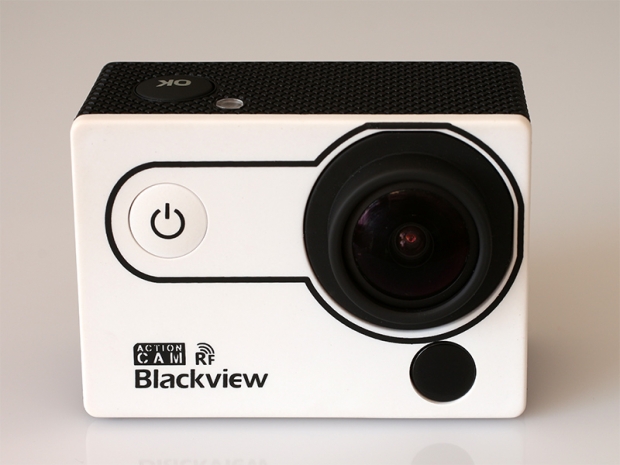Index
Retail Packaging and Accessories
The Blackview Hero 2 RF arrived in a very attractive retail pack, very similar to GoPro Hero advanced models. A transparent plastic cube covers the camera and the RF remote, while the bottom cardboard part of the package contains a USB charger (5V 2A), USB cable, user manual and a whole range of camera mounts and accessories.

The full package contents are: Blackview Hero 2 RF camera, RF wireless remote, battery, charger, USB cable, protective camera case with two back doors (waterproof and cut-out) and a GoPro mount, skeleton camera case with two standard photo 1/4“-20 UNC threads for tripods (top and bottom threads), clamp that attaches to the back of the skelton case, two clip bases with adhesive 3M tape, two spare peices of adhesive 3M tape, two different clip mounts, GoPro mount with standard photo thread, GoPro mount with standard photo screw, bycicle mount, three different GoPro switch adapters, three strong and wide adjustable straps, two smaller velcro straps, short piece of wire rope, four cable binders, a small microfiber cloth and, lastly, a user manual.
This is a really generous accessory pack bundled with the camera, and you should have no trouble attaching the camera to almost anything if you play around with the supplied accessories. Now, let's take a look under the bonnet.
Blackview Hero 2 RF Specifications
- Image Sensor: OmniVision OV4689
- Chipset: Ambarella A7LA50
- Display: 2-inch 480 x 240 pixel LCD screen
- Lens: F2.0 170 degree wide lens
- Battery: Removable Li-Ion 1050mAh battery with 60 minutes recording time at 1080p 30fps
- Storage: MicroSD card slot, max. 64GB supported
- Video formats: Encoding format H.264, video format .MOV
- Video resolutions: 720P (1280 x 720), 1269P (2304 x 1296), 2560x1080, 1080P (1920 x 1080)
- Video System: PAL, NTSC
- Video Frame Rate: 30fps, 45fps, 60fps
- Video Output: HDMI
- Image Format: JPG
- Still Image Resolution: 4M (2688x1512), 9M (4000x2250), 16M (5312x2988), 14M (4800x2700)
- Audio System: Built-in microphone/speaker (AAC)
The official spec on the manufacturer’s website also claims burst photo mode and time lapse capabilities, along with 4x digital zoom. We will get to this later.
Interestingly, the OmniVision OV4689 is a native 4-megapixel 16:9 image sensor designed for video surveillance cameras, capable of capturing 4-megapixel HD video at 90fps, 1080p HD at 120fps and 720p HD at 180fps. The sensor also supports full resolution HDR video and promises excellent low light sensitivity. We will see how the image sensor performs paired with the Ambarella A7LA50 chipset.
After we tried out the camera, we have to correct some of the specs listed above.

We found that 30fps is actually recorded as 29.97fps, and 60 fps is actually 59,94fps, which is not a big deal, but it is important to know if you are going to edit your videos in a NLE video editing system later on. Also, 59.94fps can only be used with 720p video mode, while 1080p works with 29.97fps or 45fps. With 2.7K 2304 x 1296 and 2560x1080 shooting modes, you are limited to 29.97fps. The format of the recorded H.264 video is not .MOV, it is actually .MP4.
Also, there is no photo burst mode or time lapse mode. Digital zoom is missing too, and these options are simply not available in the settings menu. It seems as if Blackview rushed the Hero 2 launch, as the current firmware (DV800B-2015-05-14) does not support these features. We can only hope that a firmware update will address these shortcomings. The ability to shoot a few dozen photos in burst mode, or to leave your weatherproof camera somewhere to capture a time lapse video sounds tempting. While these features are not a huge deal on mobile phones, we think they are very relevant on an action camera.




